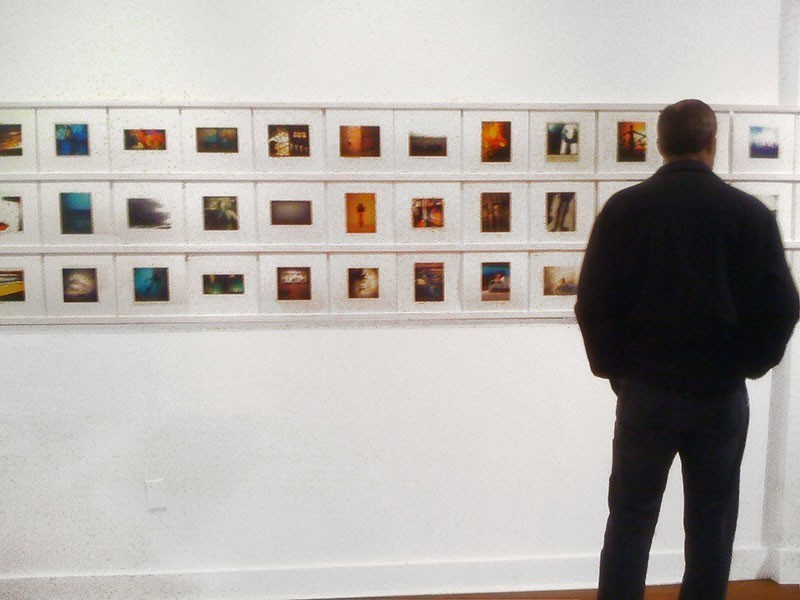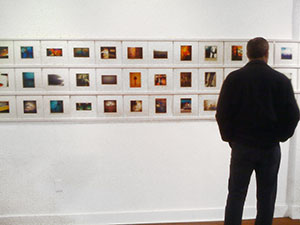Cameras have been an option on mobile phones since the late 1990’s. By 2006, half of the world’s mobile phones had a camera… less than 10 years after their introduction. The mobile phone camera was originally included as a means to quickly share instant digital snapshots. I doubt that the mobile phone camera was ever envisioned as creating a new art form. But today, some of the most creative and dynamic photographic works are being shot and processed solely with an iPhone.
My love of photography started when I was a child. My father and I would shoot Plus-X Pan film on old second-hand cameras during the day and develop it in a makeshift darkroom that night. Other than the Polaroids of the day, that’s about as instant and immediate as it got.
My original Motorola RAZR wasn’t my first mobile phone with a camera, but it was the first one I thought of as a potential artistic device. I loved that it was always with me so by extension I always had a camera with me. I actually loved the lousy, lo-fi camera on that device with its noisy, flat, low-resolution VGA output. The photos weren’t pretty, but they had texture. They were truly the digital equivalent of photos taken with a plastic toy camera. Inspired by the artwork from Underworld’s “The Riverrun Project”, I even started to shoot my own industrial photo series with the device. I thought its gray, noisy exposures were a perfect complement to industrial landscapes.
The RAZR had much of what I loved about the original iPhone 2G camera. It was always with me. The photos weren’t perfect. Images were sometimes poorly exposed. But the iPhone to me was an revolutionary device and an intriguing camera. It had a very usable (at the time) 2 megapixel output. For a mobile phone camera, the old iPhones did color surprisingly well. The photos they’d create had unique digital characteristics — color shifts and noise — not enough to be intrusive, but just enough to give them a wonderful, unique, digital lo-fi feel. The camera had no focus and no exposure override. The early iPhoneographers had to learn to shoot around the limitations of their camera. In a way, embracing these limitations freed us to focus on capturing the perfect image. It was the digital lo-fi of the original 2G that inspired me to create Life In LoFi and write about iPhone photography.
But my original iPhone 2G caught my fancy like no other camera. I now had the freedom to capture all of those found moments — people, places, light, shadow that we encounter every day. By virtue of using a mobile phone, I found I was able to capture images I never would have gotten with a “real” camera. The iPhone wasn’t invasive. It rarely influenced the subject or the scene for me in those early days. The iPhone gave me the ability to create a quality photo and get the viewer right into the middle of a scene.
Back when the internet was a smaller place (you remember 2010, don’t you?), I did some research for a history of the art I was starting to write. I didn’t want iPhoneography’s history to get lost as it grew.
In May, 2007, the Flickr group “Photos Taken With an Apple iPhone” was created — two months before the release of the iPhone 2G. The earliest use of the word “iPhoneography” I could find on the internet was 9/15/2007. A privately-named individual purchased iphoneography.info — a baffling move to me when the Holy Grail of domain names was still available at that time, the .com domain.
I’m a HUGE believer that the camera is merely a tool that the photographer uses to help create their vision. But I really think the iPhone is different (and to a lesser extent some other mobile devices) and deserves its own label. In fact, it got one in November of 2008, when Glyn Evans combined the words “iPhone” and “photography”, registered the domain and started The iPhoneography Blog. Over the years, Glyn has been key in helping build and focus the community.
It’s hard to believe that the iPhone’s App Store has only been around since July of 2008, but it was truly a milestone event in iPhone photography. For the first time, it was possible to extend and really customize the usability of your iPhone. Early photo apps like Photogene allowed you to make Photoshop-like color and image corrections right on your phone. CameraBag and lo-mob applied quick and easy analog retro camera effects. Even early apps like Polarize added the classic instant camera tonal qualities and features to this new instant digital camera medium. With the iPhone, it became possible to alter an image right on the device in a way that had never been possible on a phone or digital camera before — and then share the result instantly. Mobile phone photography became a new instant photo paradigm and the iPhone elevated it to an art.
This is what makes iPhoneography different than traditional photography, digital photography, or even other mobile phone photography. There are now thousands of apps in the Photography section of the App Store. Not only are iPhoneographers taking great photographs, many are pushing the envelope of how an image is processed as well.
Like any good photograph, it all has to start with a great image. An iPhone photograph then becomes more than just the image — it also becomes how that image was processed or “apped”. iPhone photography is a picture taken with an iPhone. iPhoneography is the entire process.
Although iPhoneography is a very electronic medium, it translates extremely well into the traditional photographic world, once again proving that the photographer’s vision makes the photograph, not the device. In late 2009, Knox Bronson created the online gallery, Pixels at an Exhibition. Pixels, as it rapidly became known, was (and still is) a curated gallery with an eye toward exceptional photography created and processed exclusively on an iPhone — a requirement Knox has vigorously defended since Pixels’ creation and one of few online galleries that only exhibits photography created and processed exclusively on an iPhone. January 30, 2010, curators Knox Bronson and Rae Douglass staged The Giorgi Gallery Show in Oakland, California. It was the first brick and mortar gallery show global in scope to feature iPhone photography exclusively. They reached out to iPhoneographers around the globe. They created an exhibition that set high standards, exemplified what the iPhone is capable of artistically and celebrated a broad range of styles coming from photographers who embraced the technology of the iPhone and the spontaneity of having an inconspicuous camera with you everywhere you go.
I was a part of that first exhibition and we flew out to the Bay Area to cover it. The experience of seeing physical iPhone photographs in a gallery setting for the first was a bit overwhelming. On display were images that I’d only seen before online in a digital space. For the first time, here was a gallery of proof that iPhoneography could hold its own in the physical world. Patrons who had no idea what their mobile phones could do were amazed by the images our iPhones captured. Many of the iPhoneographers exhibited in that first show are still active in the community today.
What continues to impress and amaze me the most about iPhoneography is how fast the art form is evolving and the movers who are driving it. iPhoneographers are not limiting themselves to one app. Many layer effects, processing images with multiple apps — experimenting with various combinations to create unique photographic effects. Many high profile iPhoneographers are not professional photographers. I regularly see outstanding works from people of all walks of life — students, mothers, accountants, everyday workers. Many people with no formal artistic training are creating some of the most exciting, compelling photographic pieces.
The art feeds itself. As the iPhone grows in popularity, there will always be those who discover the great, always-present camera on this little device. They’ll tap into an inner creativity to capture and share their vision. New classes of photo apps are always being created and copied. Some have staying power and become standards. Others are nice novelties and used for a while only to be discarded for the next new photo app. Great new apps that help push the creative envelope are always coming.
With the popularity of the iPhone, the broad range of photo apps, and the passion of all those who choose to create art and share their vision, iPhoneography has, in a few short years, greatly helped transform mobile phone photography from sharing snapshots via text message to a legitimate art form.
To me, it’s simple. iPhoneography is the art of shooting photographs, processing and sharing them using only an Apple iPhone.
I am Marty Yawnick, and I am an iPhoneographer.
=M=
~~~~
Contribute to the history. Share your own personal iPhoneography thoughts and stories in the comments below.


